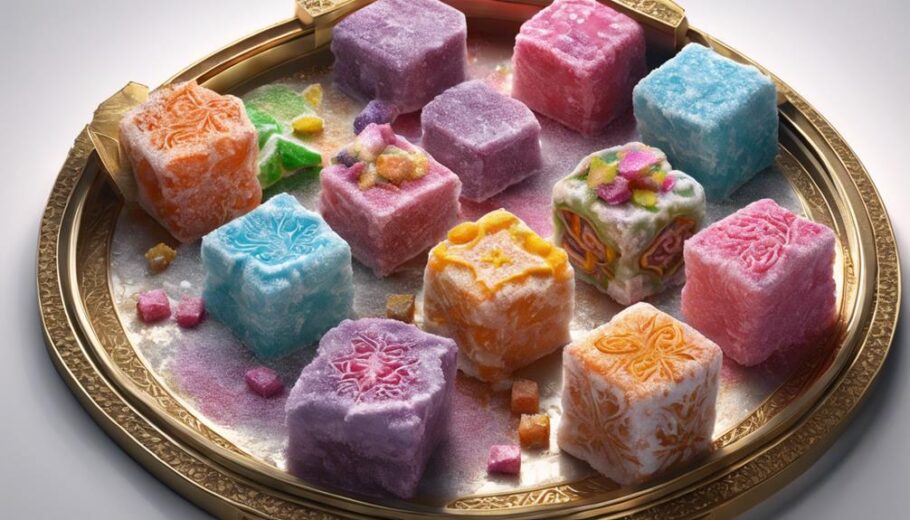Fascinated by the flavors and textures of Turkish Delight?
 Add to Recipe Book
Add to Recipe BookWhen it comes to Turkish Delight, you may be intrigued by the intricate blend of flavors and textures that set it apart from other sweets. The tantalizing combination of ingredients and the meticulous process of crafting this confectionery delight offer a glimpse into a world where tradition meets innovation. So, what makes Turkish Delight truly stand out among desserts? Let’s explore the unique characteristics that make this treat a culinary gem worth savoring.
History of Turkish Delight
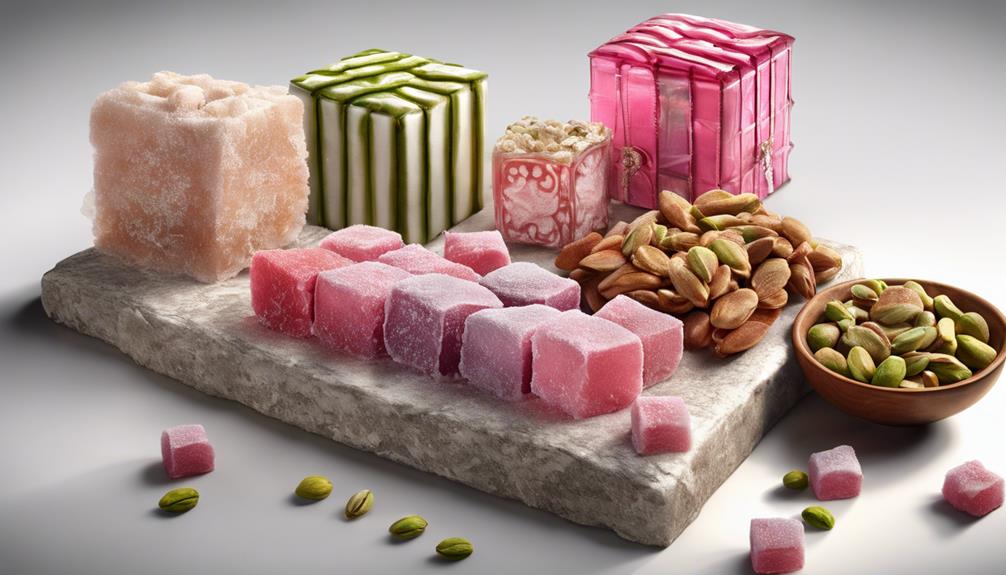
You may be surprised to learn that the history of Turkish Delight dates back to ancient times. Its origins can be traced to the Middle East, particularly in regions like Turkey, where it holds significant cultural significance. Turkish Delight, also known as Lokum, was believed to have been created during the Ottoman Empire period, making it a historical delicacy enjoyed for centuries.
Originally crafted as a treat reserved for royalty and the wealthy, Turkish Delight eventually became popular among the general population. Its cultural significance lies in its role as a symbol of hospitality and celebration, often served during special occasions such as weddings, religious holidays, and other festivities.
The process of making Turkish Delight has evolved over time, blending traditional methods with modern techniques to create the confection familiar to us today. The unique combination of ingredients like sugar, cornstarch, and various flavorings such as rosewater or citrus, contributes to its distinctive taste and texture.
As you indulge in a piece of Turkish Delight, appreciate the rich history and cultural heritage encapsulated within each bite. From its humble origins to its widespread popularity around the world, this sweet treat continues to delight taste buds and serve as a reminder of the enduring traditions it represents.
Ingredients of Lokum
Various ingredients come together to create the delectable treat known as Lokum, or Turkish Delight. This sweet treat is an integral part of Middle Eastern confectionery tradition, often enjoyed during festive occasions.
The key ingredients that give Lokum its unique taste and texture include sugar, water, and starch. Sugar is the primary component of Lokum, providing the sweetness that’s characteristic of this confection. The sugar is combined with water and cooked to create a syrupy base for the Lokum.
Starch, typically cornstarch or potato starch, is then added to the syrup to thicken the mixture and give Lokum its distinctive chewy consistency.
In addition to the basic ingredients of sugar, water, and starch, Lokum can also contain flavorings such as rosewater, orange blossom water, or lemon juice. These flavorings add a fragrant and invigorating taste to the sweet treat, enhancing its overall appeal.
Sometimes Lokum is further enriched with the addition of nuts like pistachios, hazelnuts, or walnuts. These nuts not only provide a crunchy contrast to the chewy texture of the Lokum but also add a depth of flavor that’s highly prized in Middle Eastern cuisine.
Traditional Turkish Delight Flavors
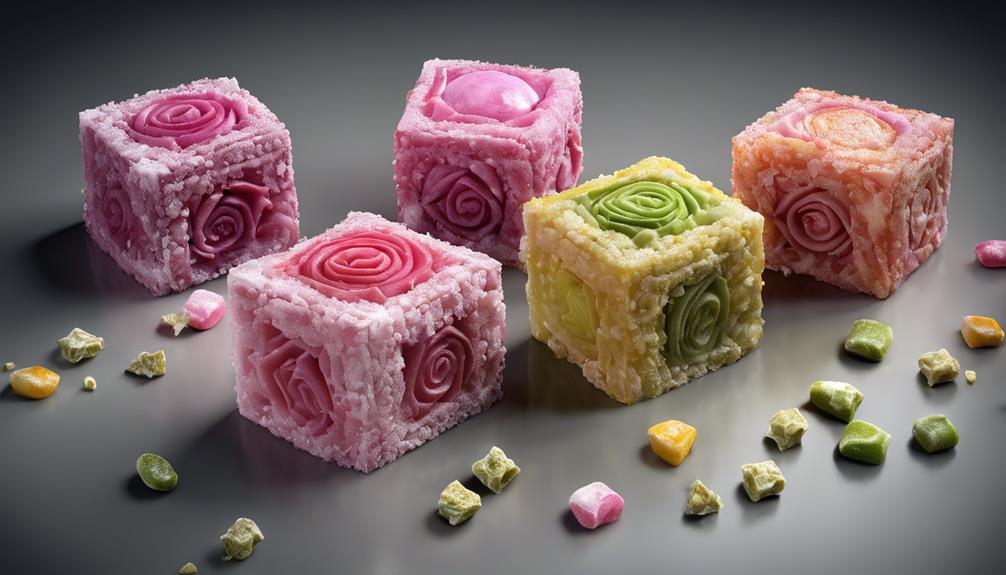
Let’s talk about the classic flavor profiles and modern taste variations that make Turkish Delight so unique.
Traditional Turkish Delight comes in a variety of flavors that have been enjoyed for generations.
From timeless favorites to innovative twists, the diverse range of tastes is sure to delight your senses.
Classic Flavor Profiles
Classic flavor profiles of Turkish Delight include rose, pistachio, and lemon, each offering a distinct taste experience. The combination of floral notes with the sweetness of rosewater creates a delicate and aromatic treat.
Pistachio Turkish Delight provides a nutty richness that complements the chewy texture, adding a delightful crunch. Lemon-flavored delights bring a invigorating zing that balances the sugary base, appealing to those who enjoy a tangy twist in their sweets. These traditional flavors showcase the essence of Turkish Delight, known for its unique textures and exotic pairings.
The sweet and savory twists in Turkish Delight are exemplified by the fusion of flavors like rose and pistachio, where the floral essence intertwines harmoniously with the earthy nuttiness. The exotic pairings found in lemon Turkish Delight offer a rejuvenating contrast, blending citrusy brightness with the candy’s sugary sweetness.
These classic flavor profiles not only showcase the versatility of Turkish Delight but also highlight the artistry behind the creation of these beloved confections.
Modern Taste Variations
Explore the evolving world of traditional Turkish Delight flavors with a modern twist. Sweet innovations and exotic combinations have brought about a delightful array of modern twists and unique flavors to this beloved confection. Below is a table showcasing some of the most popular traditional Turkish Delight flavors with a modern spin:
| Traditional Flavor | Modern Twist | Unique Combination |
|---|---|---|
| Rose | Rose with Pistachio | Rose with Lemon |
| Pomegranate | Pomegranate with Chili | Pomegranate with Mint |
| Orange | Orange with Cardamom | Orange with Chocolate |
| Hazelnut | Hazelnut with Sea Salt | Hazelnut with Coffee |
These innovative variations provide a contemporary take on the classic Turkish Delight, appealing to a wide range of palates. Whether you prefer the traditional flavors or enjoy experimenting with new taste sensations, these modern twists offer a delightful experience for all Turkish Delight enthusiasts.
Making Process of Lokum
To craft Lokum, start by combining sugar, water, and cornstarch in a saucepan over low heat. This marks the beginning of the traditional Lokum making process. The mixture is stirred continuously until it thickens and reaches a specific temperature. At this stage, various unique flavors can be added, ranging from classic rosewater and pistachio to contemporary twists like chocolate, orange, or even coconut.
Once the mixture reaches the desired consistency, it’s poured into a shallow, rectangular mold lined with powdered sugar. After allowing it to cool and set for several hours, the Lokum is cut into small cubes and dusted with more powdered sugar to prevent sticking. This time-honored method ensures that each piece of Lokum is tender, chewy, and bursting with flavor.
While traditional techniques are paramount in Lokum making, innovative variations have emerged in recent years. Artisans experiment with different ingredients, textures, and presentations to cater to diverse palates. Some producers infuse Lokum with exotic spices, nuts, or even alcohol, offering a modern twist on this beloved confection.
Whether you prefer the timeless elegance of rose-flavored Lokum or the adventurous allure of modern interpretations, the making process of Lokum remains a delicate craft that combines tradition with innovation to create a sweet treat that delights the senses.
Texture and Consistency of Turkish Delight

When enjoying Turkish Delight, one immediately notices its distinctive texture and consistency that set it apart from other confections. This sweet indulgence offers a unique mouthfeel that’s both luxurious and delightful. Turkish Delight strikes a delicate balance between being soft and firm, giving it a satisfying chewiness that keeps you wanting more.
The texture of Turkish Delight is a key factor in its appeal. As you take your first bite, you’ll experience a velvety smoothness that melts in your mouth, followed by a slight resistance that adds to the overall enjoyment. This play of textures creates a sensorial experience unlike any other, making Turkish Delight a favorite treat for many.
The consistency of Turkish Delight is where its magic truly lies. With its firm yet yielding structure, each bite offers a perfect blend of softness and resilience. This equilibrium ensures that every piece of Turkish Delight maintains its shape while still being tender and easy to eat. The satisfying chewiness of Turkish Delight makes it a joy to savor, allowing you to appreciate its flavors fully.
Varieties of Lokum Shapes
The varieties of Lokum shapes range from traditional cubes to intricately designed geometric forms, adding a visual appeal to this beloved Turkish confection. Lokum artistry plays a significant role in shaping these delightful treats, with artisans showcasing their skills through creative presentations at Lokum festivals and cultural celebrations.
At Lokum festivals, you can witness a mesmerizing display of Lokum artistry, where master confectioners craft Lokum into various shapes and sizes, transforming them into edible works of art. These festivals serve as a platform for showcasing the diverse range of Lokum shapes, from simple cubes to more intricate designs inspired by Turkish motifs and patterns.
During cultural celebrations, Lokum takes center stage in creative presentations that reflect the rich heritage and traditions of Turkey. Lokum shapes are carefully crafted to symbolize auspicious meanings or historical significance, adding a deeper layer of appreciation to these delectable sweets. Whether it’s a wedding, religious holiday, or special occasion, Lokum shapes play an essential role in enhancing the overall aesthetic appeal of the festivities.
Next time you indulge in Turkish Delight, take a moment to appreciate the artistry behind its varied shapes and the cultural significance they hold in Turkish tradition.
Health Benefits of Turkish Delight
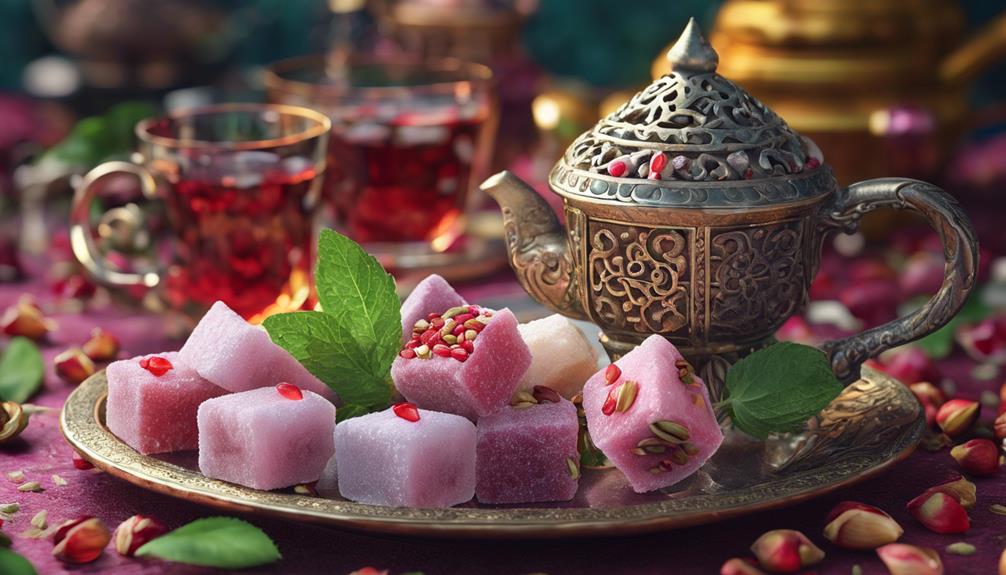
Explore the surprising health benefits that Turkish Delight offers, shedding light on how this beloved confection can contribute positively to your well-being.
Turkish Delight, also known as Lokum, not only delights your taste buds with its unique flavor combinations but also provides some nutritional benefits that might surprise you.
Here are some health advantages and traditional recipe variations that make Turkish Delight a treat worth indulging in:
- Nutritional benefits: Turkish Delight is often made with natural ingredients such as fruit juices, nuts, and honey, providing a source of vitamins and minerals that can boost your overall health.
- Traditional recipe variations: Different regions in Turkey have their own versions of Turkish Delight, incorporating local ingredients like pistachios, coconut, or rose water, each adding a distinct touch to the confection.
- Health advantages: The gelatinous texture of Turkish Delight isn’t just a delight for your palate; it can also aid digestion and soothe sore throats, making it a sweet treat with added benefits.
- Unique flavor combinations: From classic rose and lemon to more exotic combinations like pomegranate and mint, Turkish Delight offers a wide array of flavors that cater to various preferences, ensuring there’s something for everyone to enjoy.
- Antioxidant properties: Some ingredients used in Turkish Delight, such as nuts and fruits, are rich in antioxidants, which can help protect your cells from damage and support your overall well-being.
Cultural Significance of Lokum
Let’s explore the rich cultural significance of Lokum, also known as Turkish Delight.
Discover the fascinating history behind this beloved confection, the diverse ingredients and flavors that make each bite unique, and the traditional serving methods that have been passed down through generations.
This exploration will provide insight into how Lokum has become an integral part of Turkish culinary traditions and celebrations.
History of Lokum
Have you ever wondered about the origins and cultural significance of Lokum, also known as Turkish Delight? Lokum has a rich history dating back to the 18th century in Turkey, where it was initially created for the Ottoman sultans.
This delectable treat holds a special place in Turkish culture and has become a symbol of hospitality and celebration.
- Symbol of Generosity: Lokum is often offered to guests as a gesture of hospitality and goodwill.
- Traditional Celebrations: It’s a staple during special occasions like weddings, holidays, and festivals.
- Historical Roots: Lokum’s origins can be traced back to the royal kitchens of the Ottoman Empire.
- Cultural Icon: It embodies the essence of Turkish cuisine and tradition.
- Modern Adaptations: While maintaining its traditional roots, Lokum has also evolved with new flavors and variations.
The cultural significance of Lokum goes beyond just being a sweet treat; it represents a tradition of generosity, celebration, and a taste of Turkey’s rich history.
Ingredients and Flavors
Traditionally crafted with a blend of starch, sugar, and flavorings, Lokum boasts a diverse range of ingredients and flavors that reflect the cultural vibrancy of Turkish cuisine.
When it comes to flavor combinations, Lokum excels in both sweet and savory profiles, offering a delightful contrast that appeals to various palates.
The unique ingredient pairings found in Lokum showcase a fusion of traditional and modern elements, creating a harmonious blend of flavors that captivate the senses.
Traditional variations often feature ingredients like rosewater, mastic, and pistachios, providing a nostalgic taste of heritage.
On the other hand, modern twists on Lokum incorporate innovative flavors such as pomegranate, coconut, and even chocolate, appealing to contemporary preferences while staying true to its roots.
Whether you prefer the classic taste of traditional ingredients or enjoy exploring new and exciting flavor combinations, Lokum offers a delightful journey through the rich tapestry of Turkish culinary culture.
Traditional Serving Methods
In Turkish culture, the serving of Lokum holds a significant role, symbolizing hospitality and a deep-rooted tradition of sharing sweet treats with guests.
When it comes to serving this delightful confection, unique presentation and traditional customs play a crucial part in upholding the cultural significance of Lokum.
Here are some key points to keep in mind regarding the traditional serving methods of Turkish Delight:
- Unique Presentation: Lokum is often arranged on ornate trays or platters, enhancing its visual appeal and showcasing the variety of flavors available.
- Traditional Customs: Serving Lokum is often accompanied by Turkish tea or coffee, creating a harmonious balance of flavors between the sweet treat and the hot beverage.
- Serving Etiquette: It’s customary to offer Lokum to guests as a gesture of warm hospitality, showing respect and appreciation for their presence.
- Cultural Traditions: The act of serving Lokum is deeply rooted in Turkish culture, reflecting the importance of sharing joy and sweetness with others.
- Special Occasions: Lokum is commonly served during celebrations, holidays, or family gatherings, adding a touch of sweetness to the festivities.
Serving and Enjoying Turkish Delight
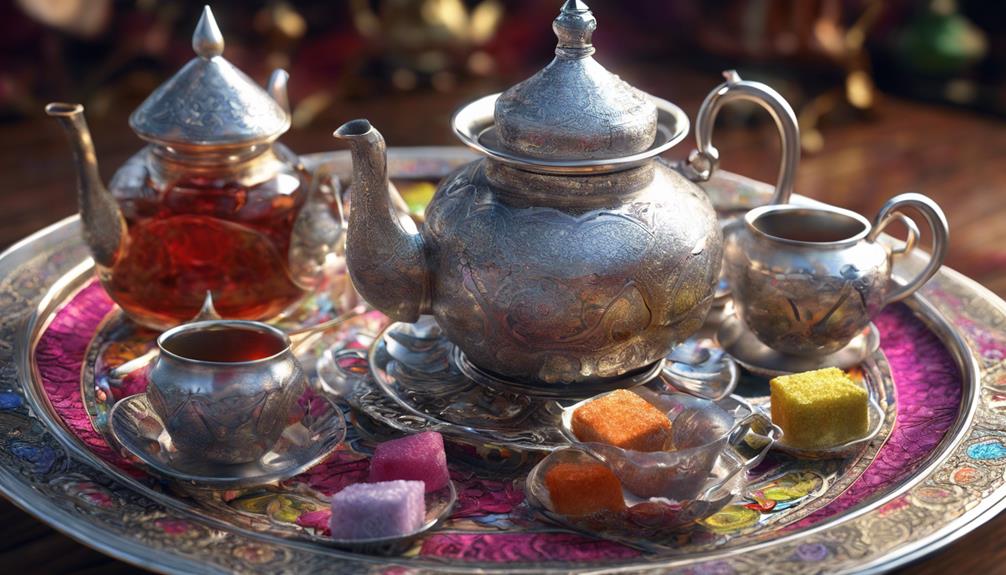
When serving and enjoying Turkish Delight, consider pairing it with a cup of traditional Turkish tea for a delightful experience. Turkish Delight is often presented in a visually appealing manner, showcasing its unique presentation as well as offering a cultural experience to those indulging in it. To fully appreciate Turkish Delight, it is essential to follow proper tasting etiquette and explore different flavor combinations.
Turkish Delight Serving Suggestions
| Serving Style | Recommended Pairing | Occasion | Flavor Combinations |
|---|---|---|---|
| Cubes on a platter | Turkish tea | Afternoon snack | Pistachio with rose water |
| Dusting with powdered sugar | Coffee | Dessert | Lemon with mint |
| Rolled in coconut flakes | Herbal tea | Relaxing evening treat | Pomegranate with orange blossom |
Pairing Turkish Delight with traditional Turkish tea enhances the overall experience by providing a balance of sweet and slightly bitter flavors. The unique texture of Turkish Delight, along with its various flavor options, allows for a customizable tasting journey. By exploring different serving styles and flavor combinations, you can truly immerse yourself in the rich cultural heritage that Turkish Delight embodies while enjoying a delightful treat.
Global Influence of Turkish Delight
The global influence of Turkish Delight is evident in its widespread popularity across various cultures and regions. This delectable treat has transcended borders and has become a beloved dessert enjoyed by people worldwide.
Here are some key aspects highlighting the global impact of Turkish Delight:
- Global Popularity: Turkish Delight’s popularity has soared internationally, with people from diverse backgrounds savoring its unique taste and texture.
- Culinary Fusion: The adaptability of Turkish Delight has led to its incorporation in various cuisines, showcasing its versatility in culinary creations.
- Cultural Symbolism: Turkish Delight serves as a symbol of Turkish culture and tradition, representing a piece of Turkey’s rich heritage.
- Sweet Diplomacy: Known as a gesture of goodwill and hospitality, Turkish Delight has been used as a diplomatic gift, fostering positive relationships between nations.
- International Variations: Different regions have put their own spin on Turkish Delight, leading to a myriad of flavors and presentations that cater to diverse palates.
Through its global popularity, cultural symbolism, and sweet diplomacy, Turkish Delight has carved out a special place in the hearts and taste buds of people around the world, showcasing the power of food to unite and delight across borders.
Frequently Asked Questions
How Long Does Turkish Delight Stay Fresh?
To keep Turkish delight fresh, store it in a cool, dry place away from sunlight. Proper storage can help extend its shelf life.
Always check the expiration date on the packaging and consume it before that date for the best taste. Preservation methods like keeping it in an airtight container can also help maintain its freshness.
Follow these storage tips to enjoy your Turkish delight for a longer period.
Can Turkish Delight Be Made With Alternative Sweeteners?
Yes, you can make Turkish Delight with sugar alternatives like honey, agave nectar, or stevia. These options may alter the taste slightly, but experimenting with different sweeteners can lead to a unique flavor profile.
Texture might be affected, so adjust recipe proportions accordingly. Using sugar alternatives can offer health benefits, making Turkish Delight a more nutritious treat.
Try different modifications to find the perfect balance of sweetness and texture for your preferences.
Are There Any Savory Versions of Turkish Delight?
Yes, there are savory options for Turkish Delight! While the traditional version is sweet, some variations incorporate savory ingredients like nuts, herbs, or spices.
These versions offer a unique twist on the classic treat, bringing a different flavor profile to the table. Experimenting with traditional ingredients in new ways can result in delicious and unexpected combinations that may surprise your taste buds.
Is Turkish Delight Gluten-Free?
Yes, Turkish Delight can be gluten-free, providing a sweet treat option for those with gluten sensitivities.
Choosing gluten-free options can be beneficial for your health if you have celiac disease or gluten intolerance.
Turkish Delight made with gluten-free ingredients can offer a delicious alternative without compromising taste or texture.
Enjoy indulging in this delightful treat worry-free while reaping the health benefits of a gluten-free diet.
Can Turkish Delight Be Used in Cooking or Baking?
Yes, Turkish delight can be used for cooking or baking. It adds a unique flavor and texture to various recipes.
When baking, you can incorporate chopped or powdered Turkish delight into cookies, cakes, or bread for a delicious twist.
For culinary applications, Turkish delight can also be melted down and used as a sweet syrup to drizzle over desserts or as a flavorful filling for pastries.
Enjoy experimenting with this versatile ingredient!
Conclusion
Indulge in the rich history, unique flavors, and health benefits of Turkish Delight.
With its soft yet firm texture and cultural significance, this sweet treat is a must-try dessert.
Whether you enjoy traditional flavors or modern twists, Turkish Delight is a versatile delicacy that has made its mark globally.
So, treat yourself to a taste of luxury and hospitality with a piece of this beloved dessert.

